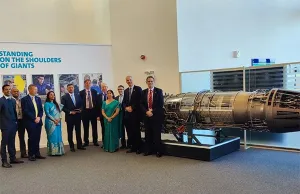Despite recent speculation, Rolls-Royce has confirmed it remains fully engaged in discussions to co-develop the engine for India’s Advanced Medium Combat Aircraft (AMCA), a fifth-generation stealth fighter currently under development.
Speaking at Aero India 2025, Alex Zino, Executive VP of Business Development & Future Programmes at Rolls-Royce, said the UK aerospace giant is still “talking to the customer,” and actively putting forward an offer via the UK government.
Strategic Technology Transfer at the Core
Zino emphasized that this isn’t just about building an engine. The proposal is part of a broader push for strategic autonomy through the Defence Partnership–India (DP-I) framework, announced during the air show.
“We’re offering to co-design and co-develop the engine in India, for India,” he said. This includes full transfer of both technical expertise and critical design knowledge—what the company calls the “knowhow and knowwhy” behind gas turbine technology.

UK’s Pitch: Fast, Local, Future-Ready
Rolls-Royce’s offer is backed by its experience from the UK’s Tempest sixth-generation fighter programme. The company says its approach brings faster timelines and tighter development cycles than previous models, positioning India to build its own capabilities for future aerospace programmes.
Beyond AMCA, the goal is to create an enduring aerospace ecosystem in India that can evolve with upcoming defence needs. “A programme like AMCA is just the trigger,” Zino noted.
Waiting for a Formal RFP
While discussions are ongoing, Rolls-Royce is still waiting on a formal Request for Proposal (RFP) from the Indian government. Zino acknowledged that there are still internal debates in India over the specifications of the engine—its size, role, and performance—but stressed the company is ready to respond when clarity comes.
“We’ll stay engaged until we’re told not to,” he said plainly.
India-UK Trade Pact Gives Civil Aviation a Boost
Zino also highlighted the recently signed Comprehensive Economic and Trade Agreement (CETA) between India and the UK as a breakthrough for commercial aerospace. The agreement aims to reduce tariffs and streamline trade in line with WTO goals, which could accelerate collaboration in both civil and defence aviation.
He noted that it would strengthen Rolls-Royce’s ties with Indian carriers like Air India and IndiGo, especially as they expand their fleets with aircraft powered by Trent XWB engines.
Civil Aviation Expansion and MRO Plans
Looking beyond defence, Rolls-Royce plans to double its aerospace supply chain output from India. The company is also evaluating the setup of a full-scale Maintenance, Repair and Overhaul (MRO) facility for civil aviation, potentially building on its existing work with Hindustan Aeronautics Ltd (HAL).
There are also plans to provide MRO support in India for the AE 2100 turboprop engine, which powers one of the aircraft under evaluation in the Indian Air Force’s Medium Transport Aircraft (MTA) project.
Policy Momentum Driving Deeper Ties
Rolls-Royce is optimistic about the recently finalised India–UK Defence Industrial Road Map, which outlines clear policy mechanisms to drive cooperation. According to Zino, the combination of this roadmap, the Vision 2035 framework, the upgraded India–UK 2+2 dialogue, and DP-I has given substance to earlier commitments.
“Strategic autonomy means owning IP, developing capability, and building supply chains in India,” he said. “The frameworks are finally in place to make that happen.”
Expanding the Indian Supply Chain
Rolls-Royce is already working closely with Indian suppliers and expects to finalise several new contracts soon. Zino praised the level of innovation and capability in the Indian supply base.If the AMCA engine project moves forward, it will significantly expand that ecosystem, supporting both defence and commercial aviation and enabling end-to-end aerospace lifecycle capability within India.
